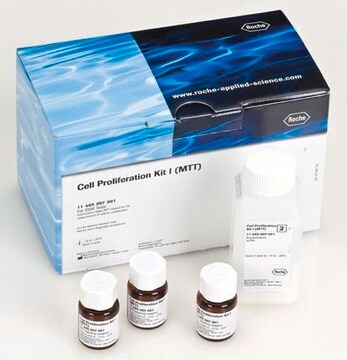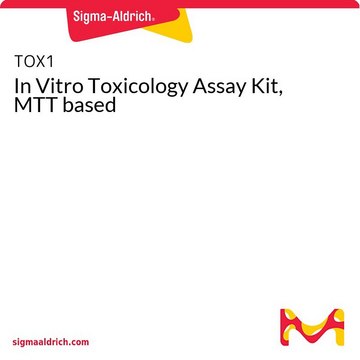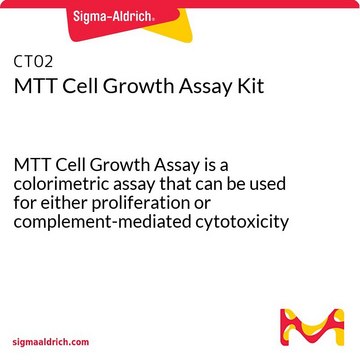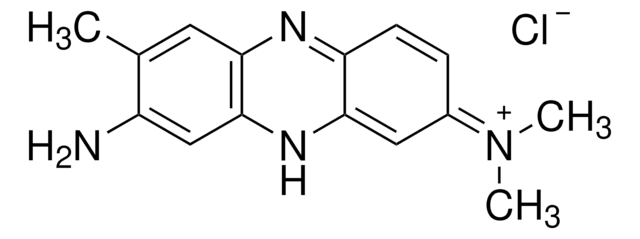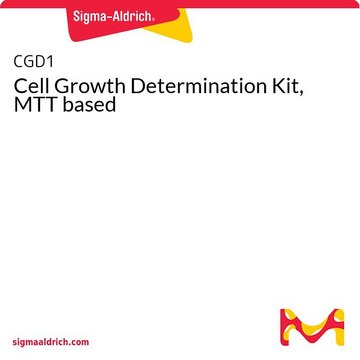TOX7
In Vitro Toxicology Assay Kit, Lactic Dehydrogenase based
Sinônimo(s):
LDH cytotoxicity assay
Faça loginpara ver os preços organizacionais e de contrato
About This Item
Código UNSPSC:
12352207
NACRES:
NA.84
Produtos recomendados
Formulário
liquid
uso
1 kit sufficient for 500 tests
embalagem
pkg of 1 kit
condição de armazenamento
dry at room temperature
técnica(s)
protein quantification: suitable
λmax
490 nm
aplicação(ões)
cell analysis
detection
método de detecção
colorimetric
temperatura de armazenamento
−20°C
Descrição geral
Tox7 is a member of Sigma′s CytoToxicity Kit series. It is based on the measurement of lactate dehydrogenase (LDH) release from cells as a measure of cell membrane damage and cytotoxicity. This technique has been utilized as an alternative to 51Cr release for cell mediated cytotoxicity assays, as well as conventional cytotoxicity resulting from interaction of a test material with the cell.
Aplicação
In Vitro Toxicology Assay Kit, Lactic Dehydrogenase based has been used:
- to detect lactate dehydrogenase release in human umbilical vein endothelial cells (HUVECs) and human cardiac myocytes (HCMs) for lactate dehydrogenase (LDH) assay
- to determine the activity of lactate dehydrogenase leakage of MDA-MB-231 cells
- to examine the activity of LDH in RAW 264.7 cells , in LDH cytotoxicity assay in human cell lines
- for spectrophotometric measurement of viable cells. Absorbance of converted dye is measured at a wavelength of 490 nm.
Ações bioquímicas/fisiológicas
The lactate dehydrogenase assay is a means of measuring either the number of cells via total cytoplasmic lactate dehydrogenase (LDH) or membrane integrity as a function of the amount of cytoplasmic LDH released into the medium. This method is simple, accurate and yields reproducible results. The assay is based on the reduction of NAD by LDH. The resulting reduced NAD (NADH) is utilized in the stoichiometric conversion of a tetrazolium dye to a soluble, colored formazan derivative.
.
.
Frases de perigo
Declarações de precaução
Classificações de perigo
Aquatic Chronic 3
Código de classe de armazenamento
10 - Combustible liquids
Escolha uma das versões mais recentes:
Já possui este produto?
Encontre a documentação dos produtos que você adquiriu recentemente na biblioteca de documentos.
Os clientes também visualizaram
Eugeniu Vasile et al.
Scientific reports, 9(1), 18685-18685 (2019-12-12)
Poly(propylene fumarate) (PPF) is a linear unsaturated polyester which has been widely investigated for tissue engineering due to its good biocompatibility and biodegradability. In order to extend the range of possible applications and enhance its mechanical properties, current approaches consist
Effects of 5-fluorouracil on morphology, cell cycle, proliferation, apoptosis, autophagy and ROS production in endothelial cells and cardiomyocytes
Focaccetti C, et al.
Testing, 10, e0115686-e0115686 (2015)
C Legrand et al.
Journal of biotechnology, 25(3), 231-243 (1992-09-01)
One significant problem in monitoring a culture's evolution is to assess change in cell viability. We have demonstrated that LDH release could be a good indicator of cellular damage of many cell lines, especially during shear stress or sonication. Moreover
Katarzyna Walczak et al.
International journal of molecular sciences, 21(21) (2020-10-30)
Tryptophan metabolites: kynurenine (KYN), kynurenic acid (KYNA) and 6-formylindolo[3,2-b]carbazole (FICZ) are considered aryl hydrocarbon receptor (AhR) ligands. AhR is mainly expressed in barrier tissues, including skin, and is involved in various physiological and pathological processes in skin. We studied the
Chiara Ceresa et al.
Molecules (Basel, Switzerland), 24(21) (2019-11-17)
Staphylococcus aureus and Staphylococcus epidermidis are considered two of the most important pathogens, and their biofilms frequently cause device-associated infections. Microbial biosurfactants recently emerged as a new generation of anti-adhesive and anti-biofilm agents for coating implantable devices to preserve biocompatibility.
Artigos
Cell based assays for cell proliferation (BrdU, MTT, WST1), cell viability and cytotoxicity experiments for applications in cancer, neuroscience and stem cell research.
Nossa equipe de cientistas tem experiência em todas as áreas de pesquisa, incluindo Life Sciences, ciência de materiais, síntese química, cromatografia, química analítica e muitas outras.
Entre em contato com a assistência técnica

